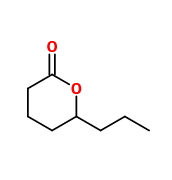
Photo credits: ScenTree SAS
| Company | Ingredient Name | ID | Comments | Naturality | Certifications | Purity | Latin name | Treated part | Geographical origin | MOQ |
|---|---|---|---|---|---|---|---|---|---|---|
|
|
(S) GAMMA HEPTALACTONE | M_0057778 |
Visit website
|
Naturel | - | - | - | - | - |
General Presentation
-
CAS N° : 105-21-5
-
EINECS number : 203-279-9
-
FEMA number : 2539
-
FLAVIS number : 10.020
-
JECFA number : 225
-
Appearance : Colorless liquid
-
Density : 1,000
-
Volatility : Base
-
Price Range : €€€
Physico-chemical properties
-
Molecular formula : C7H12O2
-
Molecular Weight : 128,17 g/mol
-
Log P : 1,09
-
Fusion Point : Donnée indisponible.
-
Boiling Point : 230°C
-
Detection Threshold : Donnée indisponible.
-
Optical rotation : Donnée indisponible
-
Vapor pressure : Donnée indisponible
-
Refractive Index @20°C : Donnée indisponible
-
Acid Value : Donnée indisponible.
-
Flash Point : 105°C
Uses
Uses in perfumery :
This lactone differs from the others by its very creamy side. It is recommended to use it to bring creamy facets to vanilla, coconut or gardenia reconstitutions.
Year of discovery :
Data not available.
Natural availability :
Gamma-Heptalactone can be found in trace amounts (< 0.5%) in Bergamot EO, in the fruit of the Jujube tree (Zizyphus jujuba), in peach, strawberry, papaya, beer or black tea. There are too few to make a natural extraction economically interesting. However, some companies are using natural qualities derived from biotechnology. The resulting price is particularly high.
Isomerism :
Gamma-Heptalactone has an asymetric carbon. The odor of the two enantiomers of this molecule is similar so, we always use its racemic mixture in perfumery. Cis-3-Hexenyl Formate is a constituent isomer of Heptalactone-gamma, but has a very different green odor.
Synthesis precursor :
Gamma-Heptalactone is not a precursor to the synthesis of another compound of olfactory interest.
Synthesis route :
Gamma-Heptalactone is a cyclic lactone synthesized in the similar way as other lactones. The reaction between acrylic acid and butanol, in the presence of an alkaline sulphate or phosphate allows this molecule to be synthesized. Intramolecular esterification of 4-hydroxyheptanoic acid, catalyzed by a strong acid such as concentrated sulfuric acid, also makes it possible. Finally, biochemical synthesis routes are being studied by the producing companies.
Regulations & IFRA
Allergens :
This ingredient does not contain any allergen.
IFRA 51th :
This ingredient is not restricted for the 51th amendment

